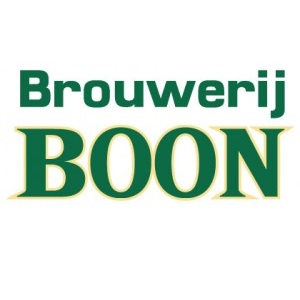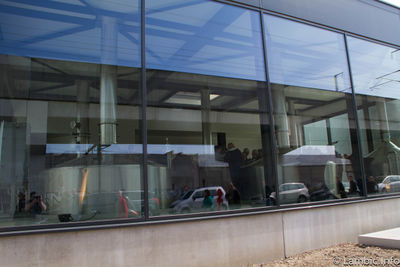Brouwerij Boon
Website : http://www.boon.be/en

Phone: +32 (0)23 56 66 44
Address: Fonteinstraat 65 Lembeek, 1502
Overview
Brouwerij Boon is a lambic brewery located in Lembeek. They produce a wide range of lambic including Oude Geuze, Oude Kriek, a sweetened kriek, faro, and several other lambics under different names of former lambic breweres including Moriau and Dekoninck. In addition to bottling their own lambic, Boon also provides wort, fruit, and facilities use to several lambic blenders.
History
Though the strand that connects Brouwerij Boon to the brewing world dates back to the 17th century, the modern history of Brouwerij Boon as a lambic producer starts around 1978 when founder and current owner Frank Boon purchased the De Vits brewery, café, and geuzestekerij when Louis De Vits and his sister Jeanne decided to retire.[1] [2] Previously, Frank had been receiving deliveries of De Vits lambic for a local youth club to which he belonged and where he began experimenting with creating faro and blending the various lambics into geuze. After taking over the De Vits name, Boon moved the business from Halle to the Hondzocht district of Lembeek. [2]
In order to continue blending lambics, Frank Boon also became a beer distributor for local brands. By 1981, Boon purchased a bankrupted factory in the center of Lembeek and moved the distributorship onto the site leaving more room for the blending business at the Hondzocht site. By 1986, the site in the center of Lembeek was home to an automatic bottling plant, a boiling kettle, and a bottle cellar.
In 1988, Frank Boon had purchased a mash tun and kettle from the Rubbens brewery and a second kettle from the Lemaire brewery, thus completing the original Boon brewhouse. Though the new brewing setup initially acted as a pilot brewery for Brouwerij De Gouden Boom (itself owned by Frank Boon and Paul Vanneste since 1983). to avoid excise tax issues, the first batch of Boon lambic was completed in fall 1990.[2] [3]
Frank Boon eventually left the distribution business due to losing exclusive rights on many of the local beers. To distribute his new lambic, Boon initially signed a deal with the Belgian wine and pirits distributor Fourcroy. The deal, which resulted in Fourcroy buying a 50% share in the new brewery, did not produce the results that Frank had hoped for. Eventually, Boon was able to buy back the shares of the brewery sold in the Fourcroy deal. In 1994 he also sold his stake in the De Gouden Boom brewery, which would also become part of the Palm Brewing group in 2003.[4] Around the same time, Boon resold a 50% stake in the brewery to the Palm Brewing group. Today under this partnership Palm offers logistical and distribution support, as well as the freedom for Boon to operate independently.
To that end, Frank Boon has acquired the name rights to many old lambic breweries and blenders including Moriau, Dekoninck, and Vandervelden[1] and continues to produce names under the Moriau and Dekoninck names. In 2011, Boon brought an entirely new brewhouse online with tanks designed specifically for lambic. [1] [2]
The importance of Brouwerij Boon and Frank Boon in the lambic community in Belgium cannot be understated. The size Boon’s infrastructure means that Frank has been able to help smaller lambic brewers and blenders in many ways. Boon sources approximately 180,000 to 190,000 kilograms of cherries per year from Galicia, a region that spans the border between Poland and Ukraine. Some of these cherries go to other brewers and blenders including 3 Fonteinen. Boon also sources approximately 28,000 kilograms of raspberries from the same area.[5] In addition to providing other lambic brewers and blenders with fruit, Boon has also bottled for 3 Fonteinen, Oud Beersel, and Mort Subite. [2] Boon lambic is also a principle component in many gueuze blends.
Frank Boon has also been instrumental in keeping the Oud Beersel brewery alive. Boon had previously supplied the brewery with malt and hops. In 1996 the bottling line (still in use from 1938) at the brewery failed and Boon began bottling for them. Starting in 1997 Boon supplied cherries to Oud Beersel for the kriek, and in 2002 when the brewery closed Boon bought the remaining stock and sold it under the Oud Beersel name. By 2005 Oud Beersel had reopened with lambic brewed at Boon with an old Vandervelden recipe. Today, Oud Beersel lambic is still brewed at Boon, barreled at Oud Beersel, and blended with over lambics including Boon.[6] Boon, along with ten other brewers and blenders make up HORAL
Beers
Geuze
- Geuze Boon
- Moriau Geuze
- Oude Geuze Boon
- Oude Geuze Mariage Parfait
- Oude Geuze Mariage Parfait single-cask editions
- Vat 44 Monoblend
Faro
Fruit
Unblended Lambic
Unclassified
Breweriana
Photos
References
- ↑ 1.0 1.1 1.2 Tim Webb, Chris Pollard, Siobhan McGinn, LambicLand: A Journey Round the Most Unusual Beers in the World, 2010
- ↑ 2.0 2.1 2.2 2.3 2.4 Jef Van den Steen, Geuze & Kriek: The Secret of Lambic Beer, 2012
- ↑ http://www.horal.be/vereniging/boon-lembeek Horal - Boon (Dutch)
- ↑ http://www.palm.be/nl/degoudenboom Palm Brewery - De Gouden Boom (Dutch)
- ↑ Frank Boon, 2010 The Lambic Summit, Part 12 (Shelton Brothers)
- ↑ Frank Boon, Boon's involvement in Oud Beersel...how long?

